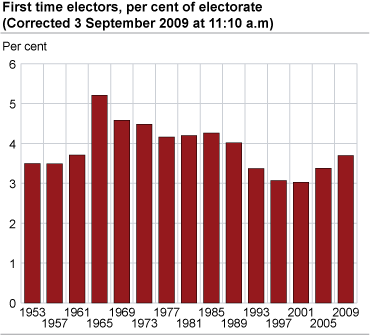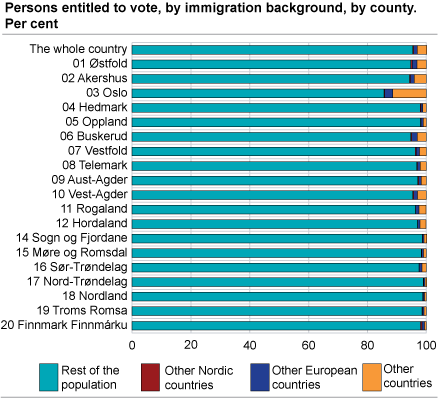Content
Published:
This is an archived release.
3 534 000 entitled to vote at the Storting election
A total of 3 534 000 people spread among 3 003 constituencies will be entitled to vote at the Storting election this year. Among these, 29 per cent are electors aged 60 years, and 3.7 per cent are first time electors. Immigrants and Norwegian-born to immigrant parents constitute 4.6 per cent. Female voters constitute 51 per cent of those entitled to vote.
In total, the number of people entitled to vote in this year’s election has increased by 3.6 percentage points since the last Storting election in 2005.
Major differences among the constituencies
There are a total of 3 003 constituencies in this year’s election. Compared to the municipal council and county election in 2007 this number has decreased from 3 127. Seventeen constituencies have more than 7 000 electors. Besides the largest constituency with 12 900 registered electors (including electors without a registered constituency), Oslo City Hall, Horten constituency in Vestfold has 11 500 electors. Askimbyen, Askim in Østfold also constitutes more than 10 000 electors - 10 700 in total.
Compared to these, a total number of 24 constituencies have 20 or fewer electors - and 7 constituencies have 10 or fewer electors. Brøstad in Dyrøy municipality, Troms county, has four electors. This is also the case for Melfjordbotn constituency in Rødøy municipality, Nordland.
On average - when electors without a registered constituency are omitted - the constituencies have 1 166 electors.
Female majority among the electorate
Even though the majority of the constituencies have a majority of male voters (57 per cent of the constituencies), females in total numbers constitute a majority in this year’s election - 51 per cent. The number of males versus females in different constituencies varies significantly. From Lauvøylandet in Alstahaug, Nordland with 67 per cent females, to Akkarvik in Skjervøy, Troms and Langfjordhamn in Loppa, Finnmark, which constitutes 80 per cent of males in the total number of electors.
A total of 1 700 of the 3 003 constituencies have a majority of males, while 1 241 constituencies have a majority of females. In 62 constituencies, males and females constitute 50 per cent each. Geographically, both Oslo and Vestfold have a majority of female electors by approximately 3 percentage points, while the situation is different in Finnmark, Sogn and Fjordane and Troms, were males constitute the majority of electors in the forthcoming election.
Total number of young electors and elderly electors
In total, 125 300 electors are entitled to vote for the first time in this Storting election. The age group 18-19 years constitutes 3.7 per cent of the total number of electors.
Eidfjord in Hordaland and Marnadal in Vest-Agder have the largest portion of first time electors, with 6 per cent. Among the counties, Rogaland and Akershus have the largest portion of first time electors in the electorate, with 4 per cent. The portion of first time electors is smallest in Oslo county, with 3 per cent.
The number of electors 60 years and older is 1 019 000, and this group of electors constitutes 29 per cent of the electorate. The portion of female electors in this group is 54 per cent. Among the counties, Oslo and Vest-Agder have the largest portions with 56 per cent and 55 per cent respectively. The portion of female electors in the group 60 years+ is smallest in Finnmark, with 51 per cent.
In total, the electors from 60 years and older constitute 30 per cent of the electorate in 10 of the counties. Hedmark and Oppland have the largest portions, while Oslo and Rogaland have the smallest portions of electors 60 years and older.
More electors among immigrants and Norwegian-born to immigrant parents entitled to vote
A total of 163 800 immigrants and Norwegian-born to immigrant parents are entitled to vote in the Storting election. Compared to the Storting election in 2005, this group has increased by 40 100 electors. As a portion of the electorate, this category have increased from 3.6 per cent in the Storting election in 2005 to 4.6 per cent in this year’s election.
The largest portion, 47 per cent, are electors with a background from Asian countries. Electors with a background from other European countries constitute 25 per cent, while electors with an African background constituting 13 per cent.
With regard to the rest of the electorate, there is a female majority among this group - approximately 52 per cent.
The largest portion of the group of immigrants and Norwegian-born to immigrant parents is found among the groups aged 18-29 years old (39 300) and 40-49 years old (39 200), while the groups aged 50-59 years old (25 500) 60+ (25 100) constitute the smallest portions. The largest single group is males aged 18-29 years old with an immigrant background from Asian countries; 10 600 electors in total.
Four counties constitute a portion that exceeds 5 per cent of the total electorate. Geographically, this group is largest in Oslo. In the capital this group constitutes 14 per cent of the total electorate, followed by electors resident in Akershus and Buskerud. The smallest portion of the total electorate is resident in Nord-Trøndelag and Nordland. In these constituencies immigrants and Norwegian-born to immigrant parents constitute 1 per cent.of the total electorate.
In total, 34 300 electors with an immigrant background will be first time voters in September. This group includes both electors below and over 20 years old. Electors with a background from Asian countries constitute the largest portion among these (17 000), while electors from other European countries follow with 7 300 first time voters.
Tables:
- Table 1 Entitled to vote 20 years and more and first-time voters 18-19 years, by sex. Storting election 2009. Absolute figures and per cent
- Table 2 Persons entitled to vote of immigrant population at the Storting election 2009, by age, sex and country background
- Table 3 Persons entitled to vote of immigrant population at the Storting election 2009, by country background and county
- Table 4 Persons entitled to vote at the Storting election 2009, by sex, municipal and constituency. Østfold
- Table 5 Persons entitled to vote at the Storting election 2009, by sex, municipal and constituency. Akershus
- Table 6 Persons entitled to vote at the Storting election 2009, by sex, municipal and constituency. Oslo
- Table 7 Persons entitled to vote at the Storting election 2009, by sex, municipal and constituency. Hedmark
- Table 8 Persons entitled to vote at the Storting election 2009, by sex, municipal and constituency. Oppland
- Table 9 Persons entitled to vote at the Storting election 2009, by sex, municipal and constituency. Buskerud
- Table 10 Persons entitled to vote at the Stortings election 2009, by sex, municipal and constituency. Vestfold
- Table 11 Persons entitled to vote at the Storting election 2009, by sex, municipal and constituency. Telemark
- Table 12 Persons entitled to vote at the Storting election 2009, by sex, municipal and constituency. Aust-Agder
- Table 13 Persons entitled to vote at the Storting election 2009, by sex, municipal and constituency. Vest-Agder
- Table 14 Persons entitled to vote at the Storting election 2009, by sex, municipal and constituency. Rogaland
- Table 15 Persons entitled to vote at the Storting election 2009, by sex, municipal and constituency. Hordaland
- Table 16 Persons entitled to vote at the Storting election 2009, by sex, municipal and constituency. Sogn og Fjordane
- Table 17 Persons entitled to vote at the Storting election 2009, by sex, municipal and constituency. Møre og Romsdal
- Table 18 Persons entitled to vote at the Storting election 2009, by sex, municipal and constituency. Sør-Trøndelag
- Table 19 Persons entitled to vote at the Storting election 2009, by sex, municipal and constituency. Nord-Trøndelag
- Table 20 Persons entitled to vote at the Storting election 2009, by sex, municipal and constituency. Nordland
- Table 21 Persons entitled to vote at the Storting election 2009, by sex, municipal and constituency. Troms Romsa
- Table 22 Persons entitled to vote at the Storting election 2009, by sex, municipal and constituency. Finnmark
- Table 23 Persons entitled to vote at the Storting election 2009, by age, sex and county
- Table 24 First-time voters 18 years and more of foreign origin, by origin. Storting election 2009
Contact
-
Statistics Norway's Information Centre
E-mail: informasjon@ssb.no
tel.: (+47) 21 09 46 42
-
Ane Margrete Tømmerås
E-mail: ane.tommeras@ssb.no
tel.: (+47) 91 99 29 62


